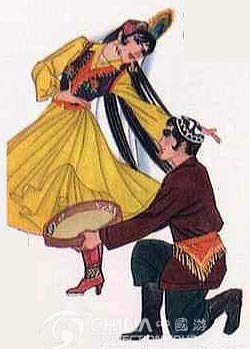
 Turpan, also referred to as Tulufan or Turfan, lies on the north branch of the Silk Road on the way to Urumqi. It is an agricultural center producing cotton and cotton textiles, silk, wheat, grapes, dried fruit and wine. Turpan is the chief town in the Turpan Basin, which is located 180 kilometers southeast of Urumqi in the eastern part of Xinjiang. This is one of the few places in the world below sea level. The depression is a long, narrow stretch of land, fifty thousand square kilometers in area, with Bogda Mountain in the north and Kurultag Mountain in the south. The depression was the center of a flourishing civilization that combined Indian and Persian elements. This civilization was later absorbed by the Uygurs, who had their capital here. Turpan is the hottest city in China and a Silk Road oasis. Peopled by Uygurs in traditional dress, Turpan is a sleepy desert town shaded by poplar trees and grape arbors. It has been blessed with well water and, through the ingenuity of its ancient inhabitants, has an intricate irrigation system that allows fruit cultivation, in particular juicy melons and plump grapes.
Turpan, also referred to as Tulufan or Turfan, lies on the north branch of the Silk Road on the way to Urumqi. It is an agricultural center producing cotton and cotton textiles, silk, wheat, grapes, dried fruit and wine. Turpan is the chief town in the Turpan Basin, which is located 180 kilometers southeast of Urumqi in the eastern part of Xinjiang. This is one of the few places in the world below sea level. The depression is a long, narrow stretch of land, fifty thousand square kilometers in area, with Bogda Mountain in the north and Kurultag Mountain in the south. The depression was the center of a flourishing civilization that combined Indian and Persian elements. This civilization was later absorbed by the Uygurs, who had their capital here. Turpan is the hottest city in China and a Silk Road oasis. Peopled by Uygurs in traditional dress, Turpan is a sleepy desert town shaded by poplar trees and grape arbors. It has been blessed with well water and, through the ingenuity of its ancient inhabitants, has an intricate irrigation system that allows fruit cultivation, in particular juicy melons and plump grapes.
Turpan is one of the most remote cities on Earth, more than 2,000 kilometers (1,240 miles) from the ocean. It is a charming and verdant oasis town, located in an area known for its hot climate and harsh desert terrain. The city lies in the Turpan Basin at the southern foot of the Tianshan Range in the eastern part of Xinjiang. The city is surrounded by Mt. Bogda, Mt. Karawuquntag, Mt. Jueluotag, Mt. Kumtag and the Hungliu River. Turpan is not only special for its low altitude, but also for its strange climate. In summer, the temperature can reach as high as 47 degrees Celsius; while on the surface of the sand dunes, it may well be 82 degrees Celsius. Called the "Land of Fire" in ancient times, it has recorded some of the hottest summer days in China.
 The city's population is 400,000, with 200,000 living in the urban area. The major nationalities are Han, Hui and Uygur. Over half the people in Turpan are Uygurs. The sound of their central Asian language flows beautifully, and many speak no Mandarin. Islamic conversion took place at the end of the 14th century, when all the Buddhist, Manichaean and Nestorian temples and monasteries were destroyed or abandoned. The region remains Muslim to this day.
The city's population is 400,000, with 200,000 living in the urban area. The major nationalities are Han, Hui and Uygur. Over half the people in Turpan are Uygurs. The sound of their central Asian language flows beautifully, and many speak no Mandarin. Islamic conversion took place at the end of the 14th century, when all the Buddhist, Manichaean and Nestorian temples and monasteries were destroyed or abandoned. The region remains Muslim to this day.
Turpan has a rich, ancient past. Many civilizations, cultures and religions put down roots here. From 20 BC to 200 AD, the Turpan oasis was a crucial point along the Northern Silk Road. When the strong Tang dynasty ruled both China and the Turpan Basin, Turpan enjoyed its golden age. After the fall of Tang in 790 AD, it was invaded by Tibetans from the south. By the middle of the ninth century, a nomadic people from the Altai Mountains, the Uygurs, took over and ruled Turpan for the next few centuries. They managed to survive the Mongol terror by cooperating with the conquerors during the 13th century. From the ninth to the thirteenth century, a rich intellectual and artistic culture developed in Astana, resulting from a fusion between the original Indo-European inhabitants and the (pre-Islamic) Uygurs. It was not until the fourteenth century that the Uygurs of Turpan converted to Islam.

